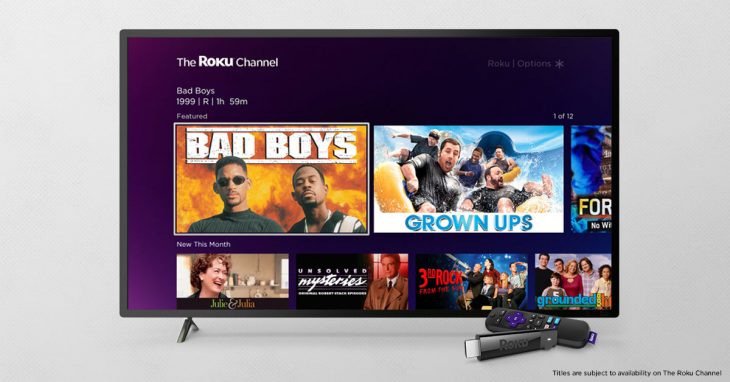
A new way for Canadian broadcasters to go direct-to-consumer
TORONTO – Roku is moving into ad-supported streaming in a big way with the launch today of The Roku Channel in Canada. The over-the-top streaming channel, which launched last September in the U.S., is targeted at cord-cutters looking for an easy way to find free movies, TV shows and more on the Roku platform.
Saratoga, California-based Roku expects the channel to be a hit with customers since it requires no subscriptions, fees or logins. It also will average about 30% less advertising per programming hour than conventional TV in Canada and won’t repeat the same ad multiple times as conventional TV often does.
Currently, the Roku streaming platform (available through its box, stick, or built in smart TV app) offers a collection of more than 5,000 free and paid-for channels that offer access to 150,000 movies and TV episodes. The Roku Channel will include new content Roku has licensed directly from studios, as well as existing content aggregated from other channel publishers on its platform.
“The channel acts like the end cap display you would find at the end of supermarket aisle but for movies” said Rob Holmes, vice president of programming at Roku. In a briefing to the press, Holmes explained that the channel will act as an entry point for viewers who don’t want to spend time subscribing to the hundreds of channels now offered on the Roku platform.
Every month The Roku Channel will feature a selection of current and classic movies, starting with Bad Boys, Julie & Julia and Grown Ups. It also provides a curated selection of content from existing channel publishers on the Roku platform. Publishers participating at launch include American Classics/Hatch Farm Studios, FilmRise and Total Content Digital; others are expected to be added over time.
The Roku Channel launches in Canada without any Canadian content partners, but Holmes says that Roku is “in a range of conversations” to add Canadian content and is also looking to add Canadian news providers. This past April Roku added live news to its channel through partnerships with Cheddar, PeopleTV and a new streaming news service called ABC News Live.
In order to track down the growing cord-cutting audiences who have migrated beyond linear TV, Holmes expects Canadian broadcasters to join the channel. During the briefing, he highlighted a report from CBC.ca that said 220,000 Canadians cancelled their TV subscriptions last year.
“The channel acts like the end cap display you would find at the end of supermarket aisle but for movies." – Rob Holmes, Roku
Just eight months after launching in the U.S. The Roku Channel is now a top 15 channel on Roku devices based on hours streamed, and is the number three free ad-supported channel on the Roku platform.
The move to add The Roku Channel in Canada is part of a strategy that began last year with the launch of a next-generation TV ad platform to boost future ad revenues while lessening its dependence on revenues from hardware sales of its Streaming Sticks.
Last year Roku also launched its Self-Serve Promotions tool which enables clients and agencies to buy targeted display ads on the Roku home screen. This was followed up with Roku Ad Insights, a new measurement suite to measure how effective its marketing is on OTT.
With Ad Insights marketers can quantify unique campaign reach by demographic segments across linear TV, OTT, desktop and mobile. TV networks and content owners can use it to measure the effectiveness of content promotions they run across the same platforms. Marketers can also target and measure campaigns delivered to Roku users who don’t have traditional pay TV subscriptions. The suite can also gather real-time feedback and demographic insights with short on-device surveys.
It should be no surprise, then, to learn that Roku’s streaming platform, not its hardware, is now for the first time leading revenue growth for the company. While Netflix, Hulu, and other major streaming services don’t let Roku directly sell ads for their apps which are available on the Roku hardware, many of the smaller content providers do and it’s adding up. Roku reported $75.1 million in platform revenues in the first quarter, up 106% year-over-year. In contrast, revenue for its streaming hardware fell 3% to $61.5 million.
This past March, Roku held its second annual client event, Roku Ad Connect, where it hosted top agencies and advertising clients, representing a significant portion of Roku’s projected 2018 ad revenues, and a majority of all U.S. ad spend annually.
Building a direct-to-consumer (D2C) OTT service is a major challenge for many content owners. “It requires the ability to aggregate a very large audience, build critical mass of content, develop advanced software and user interfaces, to monetize – for example with billing and advanced TV advertising – and manage churn and engagement,” Roku noted to investors in its last quarterly statement.
This, it contends, requires sophisticated software, big data and machine learning, and navigating complex regulatory frameworks. For that reason, and with 21 million active accounts, Holmes believes content owners will increasingly choose to distribute their content directly on Roku’s platform via The Roku Channel over creating their own D2C service.
In fact, Corus Entertainment CEO Doug Murphy said in a recent Cartt.ca report that going this route with an established streamer, with his content and channels, instead of going D2C by itself to try to reach Canadian cord cutters, is something he wants to pursue.



